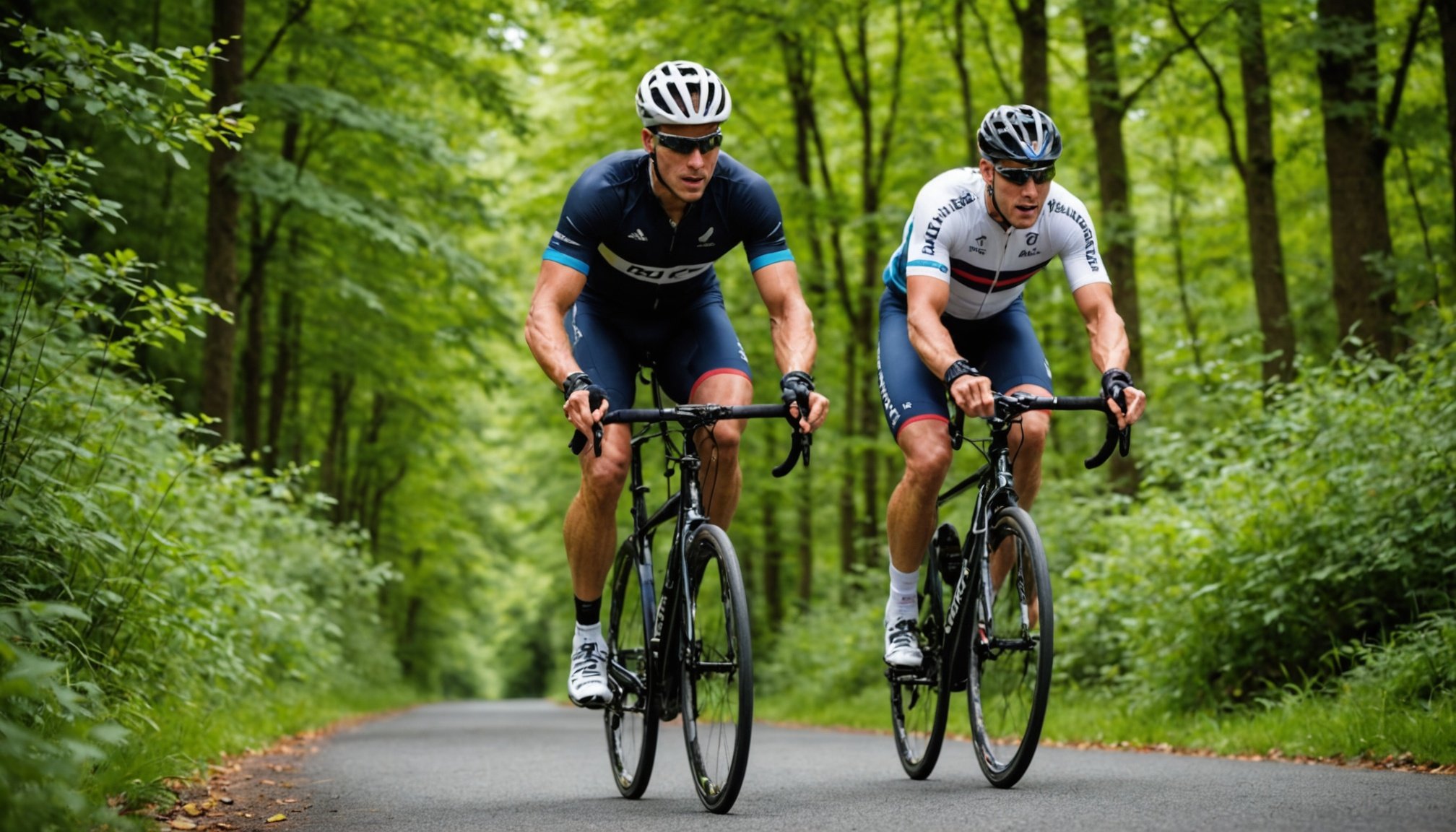Discover Your Ideal Heart Rate Zone for Maximum Fat Burning While Cycling
When it comes to cycling, understanding your heart rate zones can be a game-changer for optimizing your fitness goals, particularly if you’re aiming to burn fat and improve your overall health. Here’s a comprehensive guide to help you discover your ideal heart rate zone for maximum fat burning while cycling.
What Are Heart Rate Zones?
Heart rate zones are a way to measure the intensity of your exercise based on your heart rate. There are typically five heart rate zones, each corresponding to a different percentage of your maximum heart rate (max HR).
Have you seen this : Ultimate Guide to Effective Pacing Strategies for Endurance Events: Master Multi-Day Sports Competitions!
Understanding the Five Heart Rate Zones
- Zone 1: Recovery Zone – This is the lowest intensity zone, typically below 50% of your max HR. It’s ideal for warm-ups, cool-downs, and recovery rides.
- Zone 2: Endurance Zone – This zone, between 60-70% of your max HR, is often referred to as the “fat-burning zone” because your body primarily uses fat as a fuel source. It’s perfect for long, steady-state rides.
- Zone 3: Tempo Zone – At 70-80% of your max HR, this zone is great for building endurance and increasing your lactate threshold.
- Zone 4: Lactate Threshold Zone – This high-intensity zone, at 80-90% of your max HR, is ideal for tempo running, longer intervals, and threshold training.
- Zone 5: VO2 Max Zone – The highest intensity zone, above 90% of your max HR, is used for short, intense intervals and sprints.
How to Calculate Your Heart Rate Zones
To start using heart rate zones effectively, you need to calculate your maximum heart rate and then determine the specific heart rate ranges for each zone.
Using the Age-Based Formula
One common method to estimate your max HR is by using the age-based formula: max HR = 220 – your age. For example, if you’re 40 years old, your estimated max HR would be 180 beats per minute (bpm).
Also to read : Top Ergonomic Tips for Cyclists: Say Goodbye to Wrist Pain!
| Age | Estimated Max HR |
|---|---|
| 30 | 190 bpm |
| 40 | 180 bpm |
| 50 | 170 bpm |
| 60 | 160 bpm |
Once you have your max HR, you can calculate the heart rate ranges for each zone:
- Zone 2: 60-70% of max HR
- For a 40-year-old: 108-126 bpm (60% of 180 = 108, 70% of 180 = 126).
Using the Lactate Threshold Heart Rate Method
For a more precise calculation, you can use the Lactate Threshold Heart Rate (LTHR) method, as suggested by coach Joe Friel. This involves a 30-minute time trial to determine your average heart rate for the last 20 minutes, which serves as your LTHR. Then, you can set your zones based on percentages of your LTHR.
Why Zone 2 is Ideal for Fat Burning
Zone 2 is particularly beneficial for fat burning because it operates at a moderate intensity where your body primarily uses fat as a fuel source.
How Zone 2 Training Works
- Fuel Source: In Zone 2, your body relies more on fat for energy compared to higher intensity zones where it shifts to carbohydrates.
- Sustainability: Zone 2 training allows for longer, more sustainable workouts. This is crucial for burning fat over an extended period, as it keeps your body in a state where it continuously uses fat as a primary energy source.
- Health Benefits: Regular Zone 2 training can improve cardiovascular health, enhance endurance, and support overall weight management.
Practical Examples of Zone 2 Workouts for Cycling
Here are some practical and engaging ways to incorporate Zone 2 training into your cycling routine:
Hiking and Cross-Training
While cycling is the focus, cross-training activities like hiking can also be beneficial for maintaining fitness and staying in Zone 2.
- Hiking: A 60-minute hike at a moderate pace can be an excellent way to stay in Zone 2. Opt for trails with both flat and elevated sections to maintain a balanced intensity.
Swimming
Swimming is another full-body workout that can be adjusted to maintain a Zone 2 intensity.
- Swimming: Set a timer for an hour and swim at a comfortable pace, varying your strokes to avoid monotony. This ensures you stay within the fat-burning zone without excessive fatigue.
Cycling Workouts
Here are some specific cycling workouts designed to keep you in Zone 2:
- Steady-State Rides: Ride at a moderate pace for 60-90 minutes. This could be on a flat route or a route with gentle inclines.
- Interval Training in Zone 2: Alternate between 10-15 minutes of steady-state riding and 5-10 minutes of slightly higher intensity to keep your heart rate within the Zone 2 range.
- Group Rides: Join a group ride where the pace is moderate and consistent. This can be a fun way to stay motivated and ensure you’re in the right zone.
Tips for Effective Zone 2 Training
Here are some tips to help you make the most out of your Zone 2 training:
Use Technology to Your Advantage
- Heart Rate Monitors: Use a smartwatch or heart rate monitor to track your heart rate in real-time. This helps you stay within your target zone.
- Zone Tracking Apps: Utilize apps like those on your Apple Watch or cycling computers that can track and alert you when you’re in or out of your target zone.
Listen to Your Body
- Pace Yourself: Make sure you’re not pushing too hard, especially on inclines. The goal is to maintain a sustainable pace that keeps you in Zone 2.
- Hydration and Nutrition: Proper hydration and nutrition are crucial for long rides. Ensure you’re fueling your body adequately to maintain energy levels without overloading on carbs.
Mix Up Your Routine
- Variety is Key: Incorporate different types of workouts to avoid boredom and prevent plateaus. This could include indoor cycling, outdoor rides, and cross-training activities.
Table: Heart Rate Zones and Their Corresponding Intensities
Here’s a detailed table to help you understand the different heart rate zones and their corresponding intensities:
| Zone | % of Max HR | Description | Ideal Activities |
|---|---|---|---|
| 1 | 50-60% | Recovery Zone | Warm-ups, cool-downs, recovery rides |
| 2 | 60-70% | Endurance Zone (Fat Burning) | Long, steady-state rides, interval training in Zone 2 |
| 3 | 70-80% | Tempo Zone | Building endurance, lactate threshold training |
| 4 | 80-90% | Lactate Threshold Zone | Tempo running, longer intervals, threshold training |
| 5 | Above 90% | VO2 Max Zone | Short, intense intervals, sprints |
Quotes from Experts
Here are some insightful quotes from fitness experts to reinforce the importance of Zone 2 training:
- Martin Sharp, Physical Therapist: “Zone 2 training focuses on maintaining your heart rate and muscular activity within the weight management zone—what many refer to as the fat-burning zone.”
- Pete Davidson, Physical Therapist: “A 60-minute hike at a moderate pace is a superb way to remain in Zone 2, striking a balance between endurance and not overexerting yourself.”
- Joe Friel, Coach: “The Lactate Threshold Heart Rate method helps narrow down physiological variation to get an idea of zones, but the exact delineation depends on training history, muscle fiber typology, and metabolic context.”
Understanding and utilizing heart rate zones, particularly Zone 2, can significantly enhance your cycling workouts and overall fitness goals. By calculating your heart rate zones accurately, incorporating a variety of workouts, and using technology to your advantage, you can optimize your fat burning and improve your health.
Remember, the key to successful Zone 2 training is consistency and sustainability. Keep your workouts engaging, listen to your body, and stay within your target zone to maximize the benefits of this powerful training method. Happy cycling











